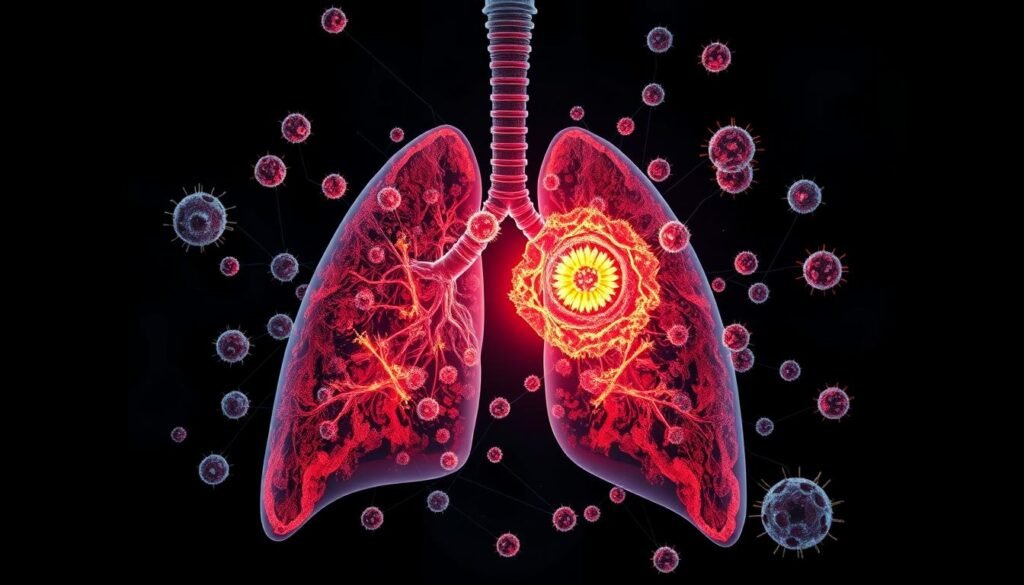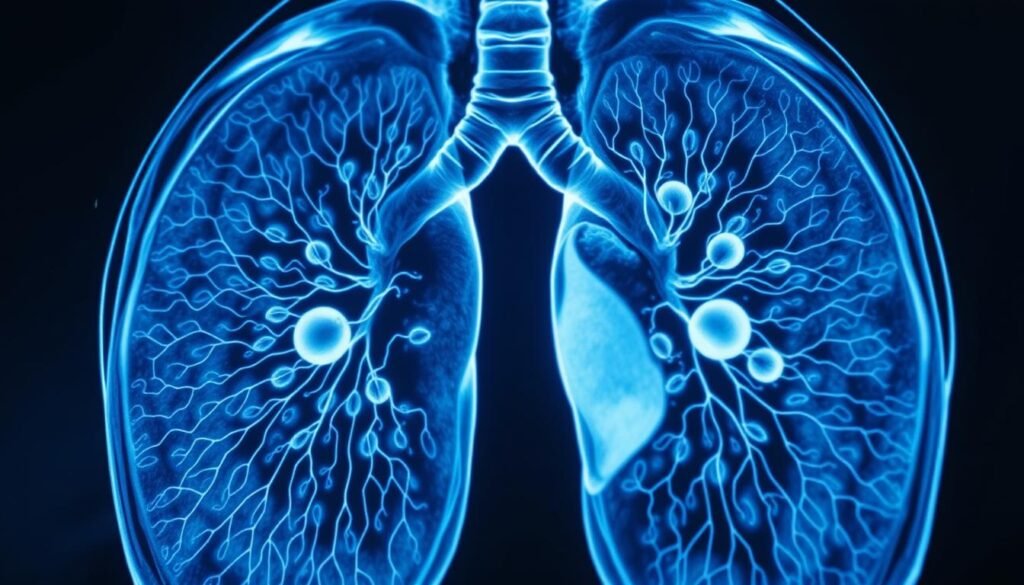Lung cancers grow fast, doubling in size about every 4 to 5 months. This quick growth is a major concern. It shows why catching the disease early is so key. Quick discovery can lead to better treatment outcomes for patients.
Understanding how quickly lung cancer grows helps doctors and patients make informed decisions. It’s all about timing treatments right to fight the disease effectively. The speed of cancer’s growth can lead to it spreading more easily. This affects a patient’s chance of survival negatively.
Key Takeaways
- Lung cancers can double in size every four to five months.
- Average doubling time for non-small cell lung cancer is 191 days.
- Smokers typically experience a faster lung cancer progression.
- Small cell lung cancer has a rapid doubling time and can spread early.
- Factors like tumor type and genetic mutations influence growth rates.
- Understanding growth rates can improve treatment strategies.
- Most lung cancers are diagnosed at advanced stages, complicating prognosis.
Understanding Lung Cancer
Lung cancer is a top cause of cancer deaths in the U.S. It’s complicated, with many types and stages. Usually, signs don’t show up until it’s pretty advanced. This makes catching it early tough.
At first, people may not feel sick. But as it gets worse, they might notice:
- Persistent cough
- Chest pain
- Weight loss
- Difficulty breathing
Because symptoms often stay hidden, about 55% find out their cancer has spread. Knowing how lung cancer moves forward is key. Spotting symptoms early can lead to quicker help. This could improve the chances of surviving longer.
Doctors have gotten better at treating lung cancer. They might use surgery, radiation, chemo, or targeted drugs. Each treatment has different side effects. Knowing these helps patients and families make informed choices about care.
Learning about lung cancer is important. It helps us know about its signs and how it progresses. With this knowledge, we can talk smarter with doctors. This can lead to better results for those impacted.
Types of Lung Cancer
It’s vital to know the different types of lung cancer for proper treatment. There are two main types: non-small cell lung cancer (NSCLC) and small cell lung cancer (SCLC). They grow differently and need different treatments.
Non-Small Cell Lung Cancer (NSCLC)
Non-small cell lung cancer covers about 80% to 85% of all lung cancer cases. It includes several subtypes, such as:
- Adenocarcinoma: This subtype is the most common in the U.S. It affects smokers and non-smokers, with more women getting it.
- Squamous Cell Carcinoma: This kind is often linked to smoking and usually starts in the bronchi.
- Large Cell Carcinoma: Known for growing fast, making treatment hard.
Each NSCLC subtype grows at different rates. This affects how patients are treated.
Small Cell Lung Cancer (SCLC)
Small cell lung cancer makes up about 10% to 15% of cases. It’s usually caused by smoking. SCLC spreads fast and is often found after it has spread to other parts of the body. This makes treating it quickly very important.
The Importance of Lung Cancer Growth Rate
Understanding the lung cancer growth rate is key in choosing effective treatments. Growth rates help decide when to start therapy. They signal how urgent it is to get further tests. A fast-growing tumor needs quick action. But, a slow-growing one allows time for genetic testing.
The term doubling time is very important. It means how long it takes for a tumor’s volume or mass to double. This doubling time changes based on the type of lung cancer. Here’s some data:
| Subtype | Volume Doubling Time (VDT, days) | Mass Doubling Time (MDT, days) |
|---|---|---|
| Acinar | 603.2 | 639.5 |
| Lepidic | 1140.6 | 970.1 |
| Solid/Micropapillary | 232.7 | 221.8 |
| Papillary | 599.0 | 624.3 |
| Invasive Mucinous | 440.7 | 438.2 |
| Squamous Cell Carcinoma | 149.1 | 146.1 |
These numbers show how tumors behave differently. They help doctors plan when to treat and what methods to use. Knowing about lung cancer’s growth lets doctors customize treatment. This improves chances for successful outcomes.
Factors Influencing Lung Cancer Progression
Lung cancer progression involves many elements. Knowing what affects lung cancer helps us understand how it will act in someone’s body. Important influences are the type of tumor, genetic changes, and whether the person has smoked. Each one affects how lung cancer grows and its effect on health.
Tumor Type and Subtype
The kind of tumor is key in lung cancer outcomes. Non-small cell lung cancer (NSCLC) and small cell lung cancer (SCLC) grow at different speeds. NSCLC makes up about 85% of cases and spreads slower than SCLC. SCLC is quicker and more vicious. These differences impact patient’s prognosis and treatment choices.
Genetic Mutations
Genetic changes play a big role in lung cancer. Mutations, like those in the EGFR gene, affect how well treatments work. For some patients, these mutations allow doctors to customize therapy. This can lead to better results. Knowing about these genetic aspects helps make care more personal.
Smoking History
Smoking is a top risk factor, linked to 80% of lung cancer deaths. Cigarettes have many carcinogens that cause mutations leading to tumors. Even second-hand smoke raises lung cancer risk. Looking at smoking history helps with prevention and figuring out patient risk.

How Lung Cancer Growth Rate is Measured
Knowing how fast lung cancer grows is key for doctors to plan treatment. They use doubling time and growth fraction as main measures. These help understand the speed of cancer, especially in aggressive types like small cell lung cancer (SCLC).
Doubling Time Explained
Doubling time means the time it takes for a tumor to double in size. For most lung cancers, it’s about three to six months. This info lets doctors know how quickly the cancer grows. SCLC usually grows faster than non-small cell lung cancer (NSCLC), impacting how patients are treated and their outlook.
Growth Fraction and Specific Growth Rate
Growth fraction shows the percentage of cells in a tumor that are dividing. It’s crucial for understanding lung cancer’s aggression. High growth fractions mean the tumor may spread fast. SCLC, for instance, shows high growth fractions, with many patients having advanced disease when diagnosed. NSCLC typically has a slower growth fraction, affecting how doctors approach treatment.
Doctors use these measures to tailor lung cancer treatments for each person. For more info on lung cancer’s growth and spread, visit this article.
Average Lung Cancer Doubling Time
The time it takes for lung cancer to double in size is important for treatment choices. Lung cancers usually double every four to six months. This time varies a lot between different lung cancer types, like NSCLC and SCLC.
Non-small cell lung tumors tend to grow slower, taking about 134 to 191 days to double. On the other hand, small cell lung cancer grows much faster. It can double in size in just 25 to 217 days. Studies show SCLC has an average doubling time of around 86.3 days. This fast growth means doctors need to act quickly.
Patients with SCLC can have tumors that grow very fast, doubling in just 54 to 132 days. This rapid growth can make diagnosing and treating the disease harder. Sometimes, it can look like other lung issues, such as pneumonia. Knowing how fast a lung cancer grows helps doctors plan better treatments.
Stages of Lung Cancer and Their Implications
Lung cancer is grouped into stages that are key in deciding on treatments and tracking the cancer’s growth. Each stage shows how severe the cancer is and how far it has spread. This helps patients and doctors choose the best treatment plan.
Overview of Lung Cancer Stages
The system to stage lung cancer uses the TNM classification. It checks tumor size, lymph node involvement, and if the cancer has spread. The stages go from 0 to 4. Each stage indicates how much the cancer has progressed:
| Stage | Description |
|---|---|
| 0 | Very small tumor that has not spread into deeper lung tissues or outside the lungs. |
| 1 | Tumors are 4 centimeters or less, confined to the lung. Most patients may undergo minimally invasive surgery without needing chemotherapy. |
| 2 | Larger tumors over 4 centimeters or those that have spread to nearby lymph nodes within the lung. |
| 3 | Cancer present in chest lymph nodes further away from the lung or large tumors spreading to nearby lymph nodes. |
| 4 | Advanced cancer that has spread outside the chest cavity to other organs such as bones, brain, and adrenal gland. |
Impact of Staging on Treatment Options
Knowing the exact stage of lung cancer is crucial for choosing treatments. For instance, most people with stage 1 non-small cell lung cancer (NSCLC) can have surgery without needing more therapy. As lung cancer gets worse, treatment tends to involve more methods, tailored to each patient. Small cell lung cancer is often found at late stages (3 or 4), leading to more complicated treatment strategies. For more information on lung cancer stages, check out this resource.
Lung Cancer Growth Rate and Metastasis
Lung cancer spreading, or metastasis, changes patient treatment and survival rates. About 53% of lung cancers have spread at diagnosis time. With small cell lung cancer (SCLC), this is even more common—two-thirds have spread. It spreads quickly, making it vital to understand how fast it grows.
Lung cancer mostly spreads to the brain, liver, and bones. These areas complicate treatment and affect survival. For example, patients with non-small cell lung cancer (NSCLC) that hasn’t spread have a 65% chance of surviving 5 years. But if it has spread far, the chance drops to 9%.
Many factors influence cancer spreading. These include genetic changes, the type of tumor, and the patient’s health. Patients found early, with cancer still local, have a better chance of surviving more than 5 years—63.7% do.

Knowing how fast lung cancer grows helps in making treatment plans. SCLC especially doubles quickly, every 86 days. This quick growth means we need fast screening and diagnosis. The American Lung Association says screening high-risk people could cut death rates by 20%. Early detection is key against this aggressive cancer.
For more on lung cancer growth and how to manage it, check this research.
Monitoring Lung Nodule Growth
Monitoring lung nodule growth is key in spotting lung cancer early. Using the right techniques is crucial to see if lung nodules might be cancerous. The growth rate of stable lung nodules is about 36.5% a year, which shows why accurate monitoring is a must.
Studies show that lung nodules on the edge of the lung grow faster, with a rate of 37.1% per year. This is compared to 25.6% for nodules in the center. Nodules next to the lung’s surface grow even faster at 38.9% each year. Meanwhile, nodules further in grow slower at 34.0%.
Finding cancerous nodules early is crucial. In one study, eight cancerous nodules grew at a rate that pointed to cancer. These were found on average in 183 days, quicker than the 344 days it takes with older methods. This highlights how valuable modern imaging, like low-dose CT scans, can be. They give us important information with less exposure to radiation.
Things like a nodule’s shape, edges, and density affect how fast it grows. The difference in how people interpret these features shows why careful monitoring is very important. Even small nodules, as tiny as 5 mm, can be closely watched with CT scans done within 30 days.
- Growth rate estimates are impacted by nodule location:
- Peripheral nodules: 37.1% standard deviation
- Central nodules: 25.6% standard deviation
- Adjacent nodules: 38.9% standard deviation
- Farther nodules: 34.0% standard deviation
- Fast detection of malignant nodules
- Lower average diagnosis time using growth rates
Considering that 33% of noncalcified nodules are found in screenings, monitoring their growth is very important. 13% are found outside of screenings. Guidelines from the BTS and the Fleischner Society set follow-up sizes at 5 mm or 80 mm³ and 6 mm or 100 mm³, respectively. This helps healthcare workers watch for changes over time. They can act fast on any signs of lung cancer.
Computed Tomography Scans in Lung Cancer Diagnosis
Computed tomography (CT) scans are crucial in finding and watching lung cancer. They give clear images of the lungs, better than typical X-rays. Imaging technology like this is key for spotting lung tumors early. Studies show CT scans can catch tiny changes in tumor size, with more than half of lung tumor changes being over 1 mm.
A study focusing on non-small-cell lung cancer patients found noncontrast chest CT scans very accurate. They used newer technology, and the average tumor size change was +4.3%. Impressively, 84% of these changes were within ± 10%. This proves CT scans’ worth in checking if a tumor is growing or not.
CT scans are especially good at finding small lung nodules. They can spot every nodule over 10 mm, crucial for early lung cancer discovery. Many lung tumors found in CT screenings were at stage I or could be removed, showing the power of early detection.

Yet, CT scans for lung cancer screening have hurdles. Over 90% of nodules they find might not be cancer. So, it’s important to use the right criteria to tell harmless from harmful findings. This helps doctors make the best care choices for patients.
| Measurement Changes | Percentage |
|---|---|
| Changes exceeding 1 mm | 57% |
| Changes exceeding 2 mm | 33% |
| Median increase | +4.3% |
| Median decrease | -4.2% |
| Within ± 10% | 84% |
| Criteria for progression | 3% |
Oncology Treatments Based on Growth Rate
Lung cancer treatment heavily depends on how fast the cancer grows. This factor is key in picking the best treatment. People with different stages of non-small cell lung cancer (NSCLC) get treatments suited to their cancer’s traits. For the earliest stage of NSCLC, surgery might be all they need. This can offer a high chance of full recovery without chemotherapy or radiation.
The higher the lung cancer growth rate, the more complex the treatment plan. For stage I NSCLC, surgery might be the sole treatment. But, with stage II NSCLC, doctors might suggest chemotherapy before surgery. They also consider if the cancer has reached the lymph nodes for deciding on further treatments.
In later stages, like IIIA and IIIB, treatment involves radiation, chemotherapy, and maybe surgery. The treatment mix rests on the tumor size, lymph node status, and patient’s overall health. Dealing with stage IV NSCLC, where cancer has spread, posits more challenges. Despite the difficulty in curing, various treatments can extend life and ease symptoms.
Finding gene changes, like KRAS, EGFR, and ALK, helps pick targeted therapies in later stages. This makes treatments more personalized. Overall, patient results greatly improve when oncologists use all available data on growth rates and treatments early.
For more details on lung cancer treatment and outlook, learn more here.
| Stage of Lung Cancer | Treatment Options | Notes |
|---|---|---|
| Stage 0 NSCLC | Surgery alone | Usually curable, no need for chemotherapy or radiation |
| Stage I NSCLC | Lobectomy | Preferred to achieve the best chance of cure |
| Stage II NSCLC | Neoadjuvant chemotherapy plus surgery | Lymph node involvement impacts follow-up treatments |
| Stage IIIA NSCLC | Combination of chemotherapy, radiation, and possibly surgery | Treatment tailored based on tumor characteristics |
| Stage IIIB NSCLC | Chemotherapy plus radiation; may include targeted therapy | Consider clinical trials for complex cases |
| Stage IV NSCLC | Chemotherapy, immunotherapy, and targeted therapy | Focus on improving survival and symptom management |
Conclusion
Understanding how lung cancer grows is key to improving patient care. Every year, about 234,580 people in the United States get diagnosed. Knowing about the growth rate is crucial for spotting symptoms and picking the right treatment.
Recognizing symptoms early can change the course of lung cancer. It’s important for everyone, including doctors, to know about these signs.
Lung cancer is a major health issue, causing 1 in 5 cancer deaths in the U.S. The average age of diagnosis is 70. This shows the need for research focused on this disease. Studying it closely can help us find better ways to prevent and treat it.
Raising awareness about lung cancer helps people understand the symptoms and risks. It also pushes for more research into effective treatments. Together, we can work to improve survival rates for those affected. Noticing early signs, like a constant cough or losing weight without trying, can lead to quick help. Learn more about symptoms here.